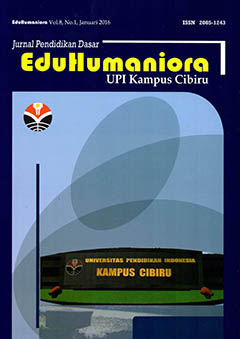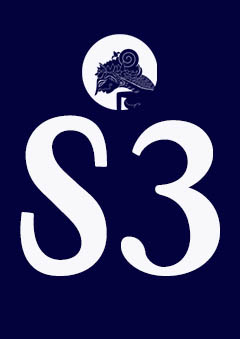EFEKTIVITAS STRATEGI PEMBELAJARAN SMART (STORIES METHOD AND RECALL TRAINING) TERHADAP PENINGKATAN MEMORI KERJA ANAK FASE SEKOLAH DASAR KELAS RENDAH
Abstract
Abstract:. This research aimed to examine the effectiveness of teaching strategy of SMART (Stories Method and Recall Training) in improving elementary children’s working memory. This strategy is designed to enable children to use their working memory efficiently through encoding (stories) and information retrieval training (recalling) in one series of cognition process. The research design applied is one group pretest-posttest design, using a group of subject of 15 elementary students at 7-9 years of age. The researcher used working memory instrument as the measurement of subject response which is developed by the researcher herself with five times of measurement and three times of treatments. The findings show that working memory capacity increases along as they age, and the SMART method improve children’s memory significantly.
Abstrak: Penelitian ini bertujuan untuk menguji efektivitas strategi pembelajaran SMART (Stories Method and Recall Training) terhadap peningkatan memori kerja anak fase sekolah dasar kelas rendah. Strategi ini dirancang agar anak dapat menggunakan memori lebih efisien melalui latihan penyandian (stories) dan perolehan kembali informasi (recalling) dalam satu rangkaian proses kognisi. Desain penelitian yang digunakan adalah one group pretest-posttest design, dengan menggunakan sekelompok subjek anak usia sekolah dasar kelas rendah rentang usia 7-9 tahun sejumlah 15 orang. Pengukuran respon subjek menggunakan insrumen memori kerja yang dikembangkan sendiri oleh peneliti, yang dilakukan sebanyak lima kali dengan tiga kali pemberian intervensi. Hasil penelitian menunjukan bahwa kapasitas memori kerja meningkat seiiring dengan bertambahnya usia, dan pelatihan strategi pembelajaran SMART (Stories Method and Recall Training) efektif meningkatkan memori kerja anak
Keywords
Full Text:
PDFReferences
Adams, J.W., Hitch, G.J. (1997). Working Memory and Children’s Mental Addition. Journal of Experimental Child Psychology, 1997;67, 21–38. DOI: 10.1006/jecp.1997.2397
Alloway, R.G.,Alloway, T.P.(2009). Investigating The Predictive Roles of Working Memory and IQ in Academic Attainment, 106(2010), 20-29 DOI: 10.1016/j.jecp.2009.11.003
Baddeley, A. (2014). Essentials of Human Memory Classic Edition. New York: Psychology Press. Retrieved 2 April 2016 from: https://books.google.co.id/books?id=2YY3AAAAQBAJ&printsec=frontcover&source=gbs_ge_summary_r&cad=0#v=onepage&q&f=false
Cain K, Oakhill J, Bryant PE. (2004). Children's Reading Comprehension Ability: Concurrent Prediction by Working Memory, Verbal Ability, and Component Skills. Journal of Educational Psychology,96, 31–42. DOI: 10.1037/0022-0663.96.1.31.
Cowan, N. (2005). Working Memory Capacity. UK: Psychology Press.
Gathercole, S. E., Pickering, S. J., Knight, C., & Stegmann, Z. (2004). Working Memory Skills and Educational Attainment: Evidence from National Curriculum Assessments at 7 and 14 Years of Age. Applied Cognitive Psychology, 18, 1–16.
Gathercole SE, Durling M, Evans S, Jeffcock E, Stone S. (2007). Working Memory Abilities and Children’s Performance in Laboratory Analogues of Classroom Activities. Applied Cognitive Psychology.2007;22, 1019–1037. DOI: 10.1002/acp.1407
Gordon, B., Berger, L.(2003). Memori Inteligen:Rahasia untuk Meningkatkan Memori Anda. Jakarta: Esensi Erlangga Group
Heppner, Paul P. (1992). Research Design in Counseling. Belmont, California: Wadsworth, Inc
Kuswana, W.S. (2011).Taksonomi Berpikir..Bandung: PT Remaja Rosdakarya
Makmun, Abin Syamsuddin. (2003). Psikologi Kependidikan: Perangkat Sistem Pengajaran Modul. Bandung: Rosda
Matlin, Margaret W. (2014).Cognitive Psychology.Eighth Edition.John Wiley & Sons Singapore Pte. Ltd.
Morin, A. (2013). 5 Ways Kids Use Working Memory to Learn. Retrieved April 27, 2016, from https://www.understood.org/en/learning-attention-issues/child-learning-disabilities/executive-functioning-issues/5-ways-kids-use-working-memory-to-learn
Oberauer K, Süß H-M, Wilhelm O, Wittmann WW. (2008). Which Working Memory Functions Predict Intelligence? Intelligence. 36, 641–652. DOI: 10.1016/j.intell.2008.01.007.
Okano, H., Hirano, T., & Balaban, E. (2000). Learning and Memory. PNAS 97 (23), pp. 12403–12404. Retrieved from:http://www.pnas.org/content/97/23/12403.full.pdf
DOI: https://doi.org/10.17509/eh.v10i2.10874
Refbacks
- There are currently no refbacks.
Copyright (c) 2018 EDUHUMANIORA: Jurnal Pendidikan Dasar
EduHumaniora: Jurnal Pendidikan Dasar
Published in collaboration Program Studi PGSD UPI Kampus Cibiru
and
HDPGSDI
This work is licensed under a Creative Commons Attribution-ShareAlike 4.0 International License.















